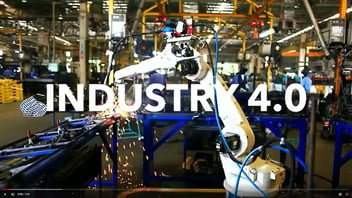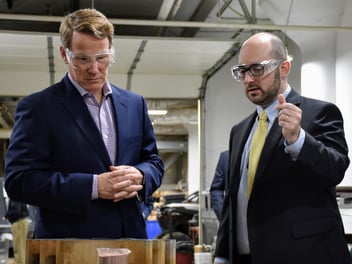Navigating the Smart Manufacturing Transformation
Local manufacturers and economic development professionals gathered at MAGNET this week to hear from a panel of experts about Navigating the Smart Manufacturing Transformation. Sponsored by AMI, CESMII, Smart Manufacturing Cluster, MAGNET, Team NEO, and Case Western Reserve University, the panel of experts aimed to share strategies for understanding topics such as smart manufacturing, the digital thread, and cybersecurity, and how to properly plan for them.
Smart manufacturing uses advanced technologies, such as AI, cloud connectivity, and industrial IoT (IIoT), to increase the efficiency and agility of traditional manufacturing processes. Speakers from Rockwell, AMI, Manufacturing Works, and MAGNET shared their thoughts on specific aspects of this transformation.
Mike Yost, the Director of Manufacturing Excellence at Manufacturing Works, shares the potential that Industry 4.0 offers for manufacturers and suppliers. He laid out the Roadmap for The Manufacturer Innovation Adoption Process, which includes: Explore, Assess, Focus, Roadmap, Execute and Sustain, and Validate. Yost shared with the audience that according to a recent McKinsey study, “Digital technologies generate impact beyond productivity to build more agile, customer-focused organizations.” As a CESMII liaison, he shared that the group is working to reduce cost, complexity and time-to-value so all manufacturers can engage in Smart Manufacturing and noted there is a Smart Manufacturing Architecture & Technologies Workshop available on-demand for free here.
Aleksander Boskovic, with Kalypso, a consulting division of Rockwell Automation, discussed what a digital thread is and why it’s important. A digital thread is the flow of information about a product's performance and use from design to production, sale, use and disposal or recycling. This provides insights into how customers use products, how those products perform, how they could be improved and what new features customers might want.
Boskovic noted that the key component is data extraction, and the “secret sauce” is entity matching to create interactive engineering diagrams. For small and medium sized businesses, it can be helpful to create a “digital twin” for a product or process. This is a digital model of an intended or real-world physical product, system, or process, contextualized in a digital version of its environment.
Rockwell recently published the 9th Annual State of Smart Manufacturing to help manufacturers benchmark technology usage, explore best practices, and uncover 2024 trends.
Mike O’Donnell from MAGNET discussed the use of IIoT (Industrial Internet of Things), which is the collection of sensors, instrument and autonomous devices connected through the internet for industrial application. He cited real-world examples of the benefits of smart manufacturing adoption, both strategically, operationally, and financially. He mentioned the example of Great Lakes Growers in Geauga County, who specialize in produce grown in a hydroponic greenhouse. Learn more about their story here.
Advanced Manufacturing International President and CEO Joe Vernase spoke to the audience about the importance of Cyber Security protocols, not just for the DOD, but for all spaces. He emphasized that Cyber Security should hold the same weight as occupational safety does today. Although it's expensive to reach any of the three levels of Cybersecurity, MSP's are available to assist with the compliance process.
Overall, the event provided beneficial information on the strategic, operational, and financial benefits of using digital methods. The speakers made it clear that there are numerous resources to help manufacturers implement these technologies to improve efficiency, security and quality, keeping them competitive in today’s global markets.




